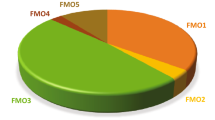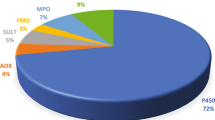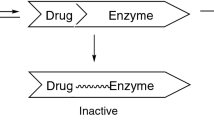Abstract
In addition to cytochrome P450, oxidation of drugs and other xenobiotics can also be mediated by non–P450 enzymes, the most significant of which are flavin monooxygenase, monoamine oxidase, alcohol dehydrogenase, aldehyde dehydrogenase, aldehyde oxidase and xanthine oxidase. This article highlights the importance of these non–P450 enzymes in drug metabolism. A brief introduction to each of the non–P450 oxidizing enzymes is given in this review and the oxidative reactions have been illustrated with clinical examples. Drug oxidation catalyzed by enzymes such as flavin monooxygenase and monoamine oxidase may often produce the same metabolites as those generated by P450 and thus drug interactions may be difficult to predict without a clear knowledge of the underlying enzymology. In contrast, oxidation via aldehyde oxidase and xanthine oxidase gives different metabolites to those resulting from P450 hydroxylation. Although oxidation catalyzed by non-P450 enzymes can lead to drug inactivation, oxidation may be essential for the generation of active metabolite(s). The activation of a number of prodrugs by non–P450 enzymes is thus described. It is concluded that there is still much to learn about factors affecting the non–P450 enzymes in the clinical situation.
Similar content being viewed by others
References
Ziegler DM. Recent studies on the structure and function of multisubstrate flavin-containing monooxygenases. Annu Rev Pharmacol Toxicol 1993;33:179–99.
Ziegler DM. Flavin-containing monooxygenases: enzymes adapted for multisubstrate specificity. Trends Pharmacol Sci 1990;11:321–4.
Jones KC, Ballou DP. Reaction of the 4α-hydroperoxide of liver microsomal flavin-containing monooxygenase with nucleophilic and electrophilic substrates. J Biol Chem 1986;261:2553–9.
Chen G-P, Poulsen LL, Ziegler DM. Oxidation of aldehydes catalysed by pig liver flavin-containing monooxygenase. Drug Met Disp 1995;23:1390–3.
Ziegler DM. Flavin-containing monooxygenases: catalytic mechanism and substrate specificity. Drug Met Rev 1988;19:1–32.
Testa B. The metabolism of drugs and other xenobiotics: Biochemistry of redox reactions. Academic Press, 1995:164–94.
Cashman JR. Enantioselective N-oxygenation of verapamil by the hepatic flavin-containing monooxygenase. Molec Pharmacol 1989;36:497–503.
Kyerematen GA, Vessell ES. Metabolism of nicotine. Drug Met Rev 1991;23:3–41.
Damani LA. Reduction and conjugation reactions of Noxides. In: Hlavica P, Damani LA, eds. N-oxidation of drugs: Biochemistry, pharmacology, toxicology. London: Chapman & Hall, 1991.
Mani C, Hodgson E, Kupfer D. Metabolism of the antimammary cancer antiestrogenic agent Tamoxifen: Flavin-containing monooxygenase-mediated N-oxidation. Drug Met Disp 1993;21:657–61.
Ibrahim KE, Smith JA, Beedham C. In vitro metabolism of chloroquine and amodiaquine in guinea pig liver slices and microsomes. J Pharm Pharmacol 1994;46S:1045.
Koppel C, Tenczer J, Ibe K. Urinary metabolism of chloroquine. Arzn Forsch 1987;37:209–11.
Ayesh R, Al-Waiz M, Crothers MJ, Cholerton S, Mitchell SC, Idle JR, Smith RL. Deficient nicotine N-oxidation in two sisters with trimethylaminuria. Br J Clin Pharmacol 1988;25:664P-5P.
Ayesh R, Mitchell, SC, Zhang A, Smith RL. The fish odor syndrome-Biochemical, familial and clinical aspects. Br Med J 1993;307:655–7.
Mitchell SC. The fish-odor syndrome. Perspect Biol Med 1996;39:514–26.
Damani LA, Hoodi AA. Cytochrome P-450 and FAD-containing monooxygenase mediated S-and N-oxygenations. Drug Metab Drug Interact 1988;6:235–44.
Ziegler DM. S-Oxygenases I: Chemistry and Biochemistry. In: Damani LA, ed. Sulphur-containing drugs and related organic compounds. Chemistry, Biochemistry and Toxicology. Vol 2, Part A. Chichester: Ellis Horwood, 1989.
Moroni P, Buronfosse T, Longin-Sauvageon C, Delatour P, Benoit E. Chiral sulfoxidation of albendazole by the flavin adenine dinucleotide-containing and cytochrome P450-dependent monooxygenases from rat liver microsomes. Drug Met Disp 1995;23:160–5.
Cashman JR, Park SB, Yang ZC, Washington CB, Gomez DY, Giacomini KM, Brett CM. Chemical, enzymatic, and human enantioselective S-oxygenation of cimetidine. Drug Met Disp 1993;21:587–97.
Rodrigues AD, Kukulka MJ, Ferrero JL, Cashman JR. In vitro hepatic metabolism of ABT-418 in chimpanzee (Pan Troglodytes): A unique pattern of microsomal flavin-containing monooxygenase-dependent stereoselective N′-oxidation. Drug Met Disp 1995;23:1143–52.
Youdim MBH, Finberg JPM. New directions in Monoamine Oxidase A and B: Selective inhibitors and substrates. Biochem Pharmacol 1991;41:155–62.
Tipton KF. What it is that I-deprenyl (selegiline) might do? Clin Pharmacol Ther 1994;56:781–96.
Strolin-Benedetti M, Dostert P, Tipton KF. Contributions of monoamine oxidase to the metabolism of xenobiotics. In: Gibson GG, ed. Progress in drug metabolism, Vol 11. Taylor & Francis, 1988.
Callingham B, Holt A, Elliott J. Properties and functions of the semicarbazide-sensitive amine oxidases. Biochem Soc Trans 1991;19:228–33.
Testa B. The metabolism of drugs and other xenobiotics: Biochemistry of redox reactions. Academic Press, 1995:212–4.
Walle T, Walle K, Mathur RS, Palesch YY, Conradi EC. Propranolol metabolism in normal subjects: Association with sex steroid hormones. Clin Pharmacol Ther 1994;56:127–32.
Beresford AP, Macrae P, Stopher DA. Metabolism of amlodipine in the rat and dog: a species difference. Xenobiotica 1988;18:169–82.
Lefebre H, Richard R, Noblett C, Moore N, Wolf LM. Life threatening pseudo-phaechromocytoma after toloxatone, terbutaline and phenylephrine. Lancet 1993:341:555–6.
Magurno J, Board A. MAOIs, OTC drugs and hypertensive crisis. J Clin Psychiatry 1990;51:212–3.
Sumatriptan. In: Martindale. The Extra Pharmacopeia, 31st edition. The Royal Pharmaceutical Society, London, 1996;485–6.
Dixon CM, Saynor DA, Andrew PD, Oxford J, Bradbury A, Tarbit MH. Disposition of sumatriptan in laboratory animals and humans. Drug Met Disp 1993;21:761–9.
Dixon CM, Park GR, Tarbit MH. Characterization of the enzyme responsible for the metabolism of sumatriptan in human liver. Biochem Pharmacol 1994;47:1253–7.
Tivol EA, Shalsh C, Schuback DE, Hsu YP, Breakefield XO. Mutational analysis of the human MAOA gene. Am J Med Gent. 1996;67:92–7.
Brunner HG, Nelen, M, Breakefiled XO, Ropers HH, van Oost BA. Abnormal behaviour associated with point mutation in the structural gene for monoamine oxidase. Science 1993;262:578–80.
Pickar D, Murphy DL, Cohen RM, Campbell IC, Lipper S. Selective and non-selective inhibitors of monoamine oxidase. Arch Gen Psychiatry 1982;39:535–40.
O'Brien EM, Tipton KF, Strolin-Benedetti M, Bonsignori A, Marrari P, Doster P. Is the oxidation of milacemide by monoamine oxidase a major factor in its anticonvulsant actions? Biochem Pharmacol 1991;41:1731–7.
Garbow JR, Ridley WP, Bork V, Pan Y, Schaefer J. Milacemide metabolism in rat liver and brain slices by solids NMR. Drug Met Disp 1994;22:298–303.
O'Brien EM, Dostert P, Pevarello P, Tipton KF. Interactions of some analogues of the anticonvulsant milacemide with monoamine oxidase. Biochem Pharmacol 1994;48:905–14.
Singer TP, Ramsay RR. The interaction of monoamine oxidases with tertiary amines. Biochem Soc Trans 1991;19:211–5.
Jurima-Romet M, Crawford K, Cyr T, Inaba T. Terfenadine metabolism in human liver: In vitro inhibition by macrolide antibiotics and azole antifungals. Drug Met Disp 1994;22:849–56.
Veronese ME, Miners JO, Rees DLP, Birkett DJ. Tolbutamide hydroxylation in humans-lack of bimodality in 106 healthy subjects. Pharmacogenetics 1993;3:86–93.
Meredith PA, Elliott HL. Clinical pharmacokinetics of Amlodipine. Clin Pharmacokin 1992;22:22–31.
Tracy JW, Catto BA, Webster LT Jr. Formation of N-(5-nitro-2-thiazolyl)-N′-carboxymethylurea from 5-hydroxyniridazole. Role of aldehyde dehydrogenase in the oxidative metabolism of niridazole. Drug Met Disp 1991;19:508–515.
Lindahl R. Aldehyde dehydrogenases and their role incarcinogenesis. Crit Rev Biochem Molec Biol 1992;27:283–335.
Vallari RC, Pietrusko R. Human aldehyde dehydrogenase: mechanism of inhibition by disulfiram. Science 1982;216:637–9.
Bosron WF, Li T-K. Alcohol Dehydrogenase. In: Jakoby WB, ed. Enzymatic basis of detoxication Vol I. Academic Press 1980;231–48.
Nakayama T, Hara A, Kariya K, Hasebe K, Inoue Y, Matsuura K, Sawada H. Hydrosteroids are physiological substrates of dehydrogenases for alicyclic alcohols and benzene dihydrodiol in rodent and rabbit liver cytosol. Prog Clin Biol Res 1987;323:415–30.
Cholerton S, Daly AK, Idle JR. The role of individual human cytochromes P450 in drug metabolism and clinical response. Trends Pharmacol Sci 1992;13:434–9.
Pietrusko R, Kurys G, Ambroziak, W. Physiological role of aldehyde dehydrogenase (EC 1.2.1.3). Alcoholism 1991;206:101–6.
Jones GL, Teng Y-S. A chemical and enzymological account of the multiple forms of human liver aldehyde dehydrogenase: Implications for ethnic differences in alcohol metabolism. Biochim Biophys Acta 1983;745:162–74.
Beedham C, Peet CF, Carter H, Panoutsopoulos GI, Smith JA. Role of aldehyde oxidase in biogenic amine metabolism (1995). In: Tipton K, Boulton AA, eds. Progress in brain research, Vol 106. Amsterdam, Elsevier: Chapter 34:345–53.
Spray HE. In vitro metabolism of quinine, tolbutamide, codeine and morphine by liver slices. PhD Thesis, University of Bradford 1996.
Yamauchi M, Maezawa Y, Mizuhara Y, Ohata M, Hirakawa J, Nakajima H, Toda G. Polymorphisms in alcohol metabolizing enzyme genes and alcoholic cirrhosis in Japanese patients; a multivariate analysis. Hepatology 1995;22:1136–42.
Agarwal DP, Goedde HW. Pharmacogenetics of alcohol metabolism and alcoholism. Pharmogen 1992;2:48–62.
Thomasson HR, Edenberg HJ, Crabb DW, Mai X-L, Jerome RE, Li T-K, Wang S-P, Lin Y-T, Lu R-B, Yin S-J. Alcohol and aldehyde dehydrogenase genotypes and alcoholism in Chinese men. Am J Hum Genet 1991;48:677–81.
Thomasson HR, Crabb DW, Edenberg HJ, Li T-K. Alcohol and aldehyde dehydrogenase polymorphisms and alcoholism. Behav Gen 1993;23:131–6.
Novoradovsky A, Tsai S-JL, Goldfarb L, Peterson R, Long JC, Goldman D. Mitochondrial aldehyde dehydrogenase polymorphism in Asian and American Indian populations: Detection of new ALDH2 alleles. Alcohol: Clin Exp Res 1995;19:1105–10.
Helander A, Walzer C, Beck O, Balant L, Borg S, von Wartburg J-P. Influence of genetic variation in alcohol and aldehyde dehydrogenase on serotonin metabolism. Life Sciences 1994;55:359–66.
Sladek NE. Metabolism of oxazaphosphorines. Pharmacol Ther 1988;37:301–55.
Chang TKH, Weber GF, Crespi CL, Waxman DJ. Differential activation of cyclophosphamide and ifosphamide by cytochromes P4502B and 3A in human liver microsomes 1993;45:1685–94.
Rekha GK, Sreerama L, Sladel NE. Intrinsic cellular resistance to oxazophosphorines exhibited by a human colon carcinoma cell line expressing relatively large amounts of a class-3 aldehyde dehydrogenase. Biochem Pharmacol 1994;48:1943–52.
Holmes EW, Wyngaarden JB. Hereditary xanthinuria. In: Scriver CR, Beaudet AL, Sly WS, Valle D, eds. The metabolic basis of inherited disease I. McGraw-Hill, 1989:1085–94.
Peterson GM, Boyle RR, Francis HW, Oliver NWJ, Paterson J, Vonwitt R et al. Dosage prescribing and plasma oxipurinol levels in patients receiving allopurinol therapy. Eur J Clin Pharmacol 1990;39:419–21.
Krenitsky TA, Spector T, Hall WW. Xanthine oxidase from human liver: Purification and characterization. Arch Biochem Biophys 1986;247:108–19.
Hall WW, Krenitsky TA. Aldehyde oxidase from rabbit liver. Arch Biochem Biophys 1986;251:36–46.
Beedham C. Molybdenum Hydroxylases: Biological Distribution and Substrate-Inhibitor Specificity. In: Ellis GP, West GB, eds. Progress in medicinal chemistry Vol 24. Amsterdam: Elsevier Science Publishers B.V. (Biomedical Division), 1987:85–127.
Beedham C, Critchley DJP, Rance DJ. Substrate specificity of human liver aldehyde oxidase toward substituted quinazolines and phthalazines: A comparison with hepatic enzyme from guinea pig, rabbit and baboon. Arch Biochem Biophys 1995;319:481–90.
Easterbrook P, Wood MJ. Successors to acyclovir. J Antimicrobial Chemotherapy 1994;34:307–11.
De Miranda P, Burnette TC. Metabolic fate and pharmacokinetics of the acyclovir prodrug valciclovir in cynomologous monkeys. Drug Met Disp 1994;22:55–9.
Jones DB, Rustgi VK, Konhauser DM, Woods A, Quinn R, Hoofnagle JH, Jay H, Jones EA. The disposition of 6-deoxy-acyclovir, a xanthine oxidase-activated prodrug of acyclovir, in the isolated perfused rat liver. Hepatology 1987;7:345–8.
Krenitsky TA, Hall M, De Miranda P, Beauchamp LM, Schaeffer HJ, Whiteman PD. 6-Deoxyacyclovir: A xanthine oxidase-activated prodrug of acyclovir. Proc Natl Acad Sci USA 1984;81:3209–13
Whiteman PD, Bye A, Fowle ASE, Jeal S, Land G, Posner J. Tolerance and pharmacokinetics of A515U, an acyclovir analogue in healthy volunteers. Eur J Clin Pharmacol 1984;27:471–5.
Weller S, Blum MR, Doucette M, Burnette T, Cederberg DM, De Miranda P, Smiley ML. Pharmacokinetics of the acyclovir prodrug, valaciclovir, after escalating single-and multipledose administration to normal volunteers. Clin Pharmacol Therapeut 1993;54:595–605.
De Miranda, P. and Good, SS. Species differences in the metabolism and disposition of antiviral nucleoside analogues: 1 Acyclovir. Antiviral Chem Chemother 1992;3:1–8.
Perry CM, Wagstaff AJ. Famciclovir. A review of its pharmacological properties and therapeutic efficacy in Herpesvirus infections. Drugs 1995;50:396–415.
Vere Hodge RA, Sutton, D, Boyd MR, Harnden MR, Jarvest RL. Selection of an oral prodrug (BRL42810; famciclovir) for the antiherpes virus agent BRL 39123 [9-(4-hydroxy-3hydroxymethyl-but-1yl)guanine; penciclovir. Antimicrob Agents Chemother 1989;33:1765–73.
Filer CW, Allen GD, Brown TA, Fowles SE, Hollis FJ, Mort EE, Prince WT, Ramji JV. Metabolic and pharmacokinetic studies following oral administration of 14C-famciclovir to healthy subjects. Xenobiotica 1994;24:357–68.
Daniels S, Schentag JJ. Drug interaction studies and safety of famciclovir in healthy volunteers: a review. Antiviral Chem Chemother 1993;4:57–64.
Rashidi MR, Smith JA, Clarke SE, Beedham C. In vitro oxidation of famciclovir and 6-deoxypenciclovir by aldehyde oxidase from human, guinea pig, rabbit and rat liver. Drug Met Disp 1997; In press.
Clarke SE, Harrell AW, Chenery RJ. Role of aldehyde oxidase in the in vitro conversion of famciclovir to penciclovir in human liver. Drug Met Disp 1995;23:251–4.
Vince R, Hua M, Brownell J, Daluge S, Lee F, Shannon WM, Lavell GC, Qualls J, Weislow OS, Kiser R, Canonico PG, Schultz RH, Narayanan VL, Mayo JG, Shoemaker RH, Boyd MR. Potent and selective activity of a new carbocyclic nucleotide analogue (carbovir; NSC 614846) against human immunodeficiency virus in vitro. Biochem Biophys Res Comm 1988;156:1046–53.
Vince R, Brownell J, Beers SA. 6-Deoxycarbovir: A xanthine oxidase activated prodrug of carbovir. Nucleosides Nucleotides 1995;14:39–44.
Huang S-H, Remmel RP, Zimmerrman CL. The bioavailability and nonlinear clearance of (-)-carbovir in the rat. Pharm Res 1991;8:739–43.
Iyer KR, Beers SA, Vince R, Remmel RP. Regioselective metabolism of (-)-6-deoxycarbovir by xanthine oxidase and aldehyde oxidases. ISSX Proceedings 1992;85.
Vince R, Hua M. Synthesis and anti-HIV activity of carbocyclic 2′,3′-didehydro-2′,3′-dideoxy-2,6-disubstituted purine nucleosides. J Med Chem 1990:33:17–21.
Kaye B, Rance DJ, Waring L. Oxidative metabolism of carbazeran in vitro by liver cytosol of baboon and man. Xenobiotica 1984;14:935–45.
Pue MA, Pratt SK, Fairless AJ, Fowles S, Laroche J, Giorgiou P, Prince W. Linear pharmacokinetics of penciclovir following administration of single oral doses of famciclovir 125, 250, 500 and 750 mg to healthy volunteers. J Antimicrob Chemother 1994;33:119–27.
Beedham C, Al-Tayib Y, Smith JA. The role of guinea pig and rabbit hepatic aldehyde oxidase in oxidative in vitro metabolism of cinchona alkaloids. Drug Met Disp 1992;20:889–95.
Jordan CG, Rashidi MR, Laljee H, Clarke SE, Brown JE, Beedham C. Formation of 7-hydroxymethotrexate from methotrexate with human and guinea pig aldehyde oxidase. Brit J Pharmacol 1996;118:111S.
Liddle C, Graham GG, Christopher RK, Bhuwapathanaoun S, Duffield AM. Identification of a new urinary metabolite in man of quinine using methane chemical ionization gas chromatography-mass spectrometry. Xenobiotica 1981;11:81–7.
Tamai G, Yoshidi Y, Imai H, Takashina T, Kotoo K, Fuwa T et al. Isolation of new quinidine metabolites and simultaneous determination of quinidine and its metabolites in blood and urine by direct injection HPLC analysis. Chromatographia 1985;20:671–6.
Ertmann R, Bielack S, Landbeck G. 7-Hydroxy-methotrexate and clinical toxicity following high-dose methotrexate therapy. J. Cancer Res Clin Oncol 1985;109:86–8.
Cambridge D. UK-14,304–18, a potent and selective a2-agonist for the characterization of an a-adrenoceptor sub-type. Eur J Pharmacol 1981;72:413–5.
Reick RJ, Walters TR, Robins AL, Barneby HS, Choplin NT, Kelly EP, et al. Brimonidine tartrate: a one month dose response study. Invest Opthamol Vis Sci 1993;34:929.
Acheampong AA, Shackleton M, Tang-Lu DD-S. Comparative ocular pharmacokinetics of brimonidine after a single dose application to the eyes of albino and pigmented rabbits. Drug Met Disp 1995;23:708–12.
Guerciolini R, Szumlanski C, Weinshilboum RM. Human liver xathine oxidase: Nature and extent of individual variation. Clin Pharmacol Ther 1991;50:663–72.
Relling MV, Lin J-S, Ayers GD, Evans WE. Racial and gender differences in N-acetyltransferase, xanthine oxidase and CYP1A2 activities. Clin Pharmacol Ther. 1992;52:643–58
Reiter S, Simmonds HA, Zollner N, Braun SL, Knedel. Demonstration of a combined deficiency of xanthine oxidase and aldehyde oxidase in xanthinuric patients not forming oxipurinol. Clin Chim Acta 1990;187:221–34.
Hamelin BA, Xu K, Valle F, Manseau L, Richer M, LeBel M. Caffeine metabolism in cystic fibrosis: Enhanced xathine oxidase activity. Clin Pharmacol Ther 1994;56:521–9.
Chang C-N, Doong S-L, Cheng Y-C. Conversion of 5-iodo-2-pyrimidinone-2′-deoxyribose to 5-iodo-deoxyuridine by aldehyde oxidase: Implication in hepatotropic drug design. Biochem Pharmacol 1992;43:2269–73.
Porter DJT, Harrington JA, Almond MR, Lowen GT, Zimmerman P, Spector T. 5-Ethynyl-2-(1H)-pyrimidinone: aldehyde oxidase-activation to 5-ethynyluracil, a mechanism-based inhibitor of dihydropyrimidine dehydrogenase. Biochem Pharmacol 1994;47:1165–71.
Guo X, Lerner-Tung M, Chen H-X, Chang C-N, Zhu J-I, Chang C-P et al. 5-Fluoro-2-pyrimidinone, a liver aldehyde oxidase-activated prodrug of 5-fluorouracil. Biochem Pharmacol 1995;49:1111–6.
Speth PAJ, Kinsella TJ, Chang AE, Klecker RW, Belanger K, Collins, JM. Selective incorporation of iododeoxyuridine into DNA of hepatic metastases versus normal human liver. Clin Pharmacol Therapeut 1988;44:369–75.
Author information
Authors and Affiliations
Rights and permissions
About this article
Cite this article
Beedham, C. The role of non—P450 enzymes in drug oxidation.. Pharm World Sci 19, 255–263 (1997). https://doi.org/10.1023/A:1008668913093
Issue Date:
DOI: https://doi.org/10.1023/A:1008668913093




